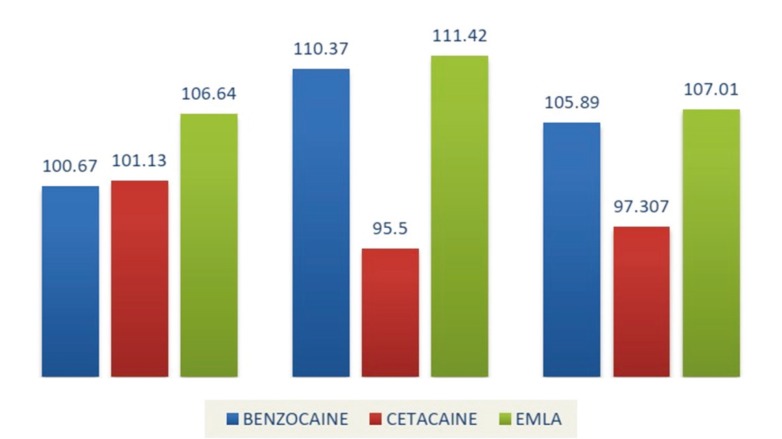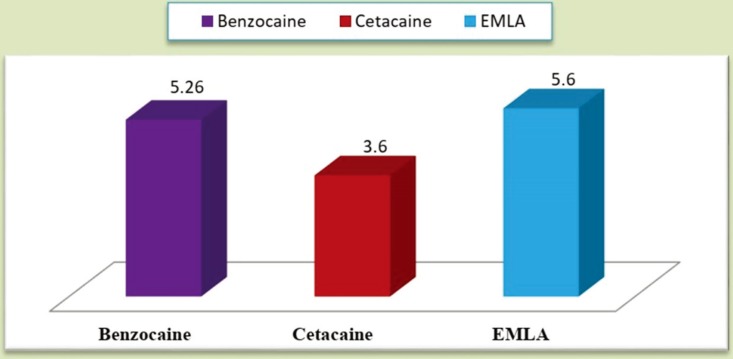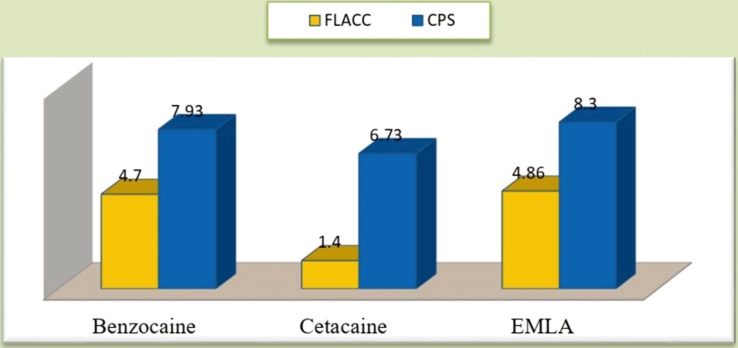J Dent Anesth Pain Med.
2020 Feb;20(1):29-37. 10.17245/jdapm.2020.20.1.29.
Comparative efficacy of three topical anesthetics on 7-11-year-old children: a randomized clinical study
- Affiliations
-
- 1Department of Pedodontics and Preventive Dentistry, Priyadarshini Dental College & Hospital, Pandur, Thirivallur, Tamilnadu, India.
- 2Department of Pedodontics and Preventive Dentistry, Narayana Dental College & Hospital, Nellore, India. nimskrishna2007@gmail.com
- KMID: 2471171
- DOI: http://doi.org/10.17245/jdapm.2020.20.1.29
Abstract
- BACKGROUND
This study evaluated the efficacy of three intraoral topical anesthetics in reducing the injection needle prick pain from local anesthetic among children aged 7-11 years old.
METHODS
It is a prospective, Interventional, parallel design, single-blind, randomized clinical trial in which subjects (n=90) aged 7-11 years were included in the study based on an inclusion criteria. Subjects were divided into three groups based on computer-generated randomization with an allocation ratio of 1:1:1. Groups A, B, and C received benzocaine 20% jelly (Mucopain gel, ICPA health products Ltd, Ankleshwar, India), cetacaine anesthetic liquid (Cetylite Industries, Inc, Pennsauken, NJ), and EMLA cream (2% AstraZeneca UK Ltd, Luton, UK), respectively, according to manufacturer's instructions, for 1 minute prior to local anesthetic injection. After application of topical anesthetic agent, for all the groups, baseline pre-operative (prior to topical anesthetic administration) and post-operative scores (after local anesthetic administration) of pulse rate was recorded using Pulse oximeter (Gibson, Fingertip Pulse Oximeter, MD300C29, Beijing Choice Electronic). Peri-operative (i.e., during the administration of local anesthesia) scores were recorded using Face, Legs, Activity, Cry, Consolability (FLACC) Scale, Modified Children hospital of Eastern Ontario Pain Scale (CPS) behavior rating scale, and Faces Pain Scale (FPS-R) - Revised (For self-reported pain). Direct self-reported and physiological measures were ascertained using FPS-R - Revised and Pulse oximeter, respectively, whereas CPS and FLACC scales assessed behavioral measures. To test the mean difference between the three groups, a one way ANOVA with post hoc tests was used. For statistical significance, a two-tailed probability value of P < 0.05 was considered as significant.
RESULTS
The Cetacaine group had significantly lower pain scores for self-report (P < 0.001), behavioral, and physiological measures (P < 0.001) than the other two groups. However, there was no significant difference between the Benzocaine group and EMLA group during palatal injection prick.
CONCLUSION
Cetacaine can be considered as an effective topical anesthetic agent compared to benzocaine 20% jelly (Mucopain gel) and EMLA cream.
Keyword
MeSH Terms
Figure
Reference
-
1. Kleinknecht RA, Klepac RK, Alexander LD. Origins and characteristics of fears in dentistry. J Am Dent Assoc. 1973; 86:842–848. PMID: 4511174.2. Holst A, Evers H. Experimental studies of new topical anesthetics on the oral mucosa. Swed Dent J. 1985; 9:185–191. PMID: 3866334.3. Nutter DP. Good clinical pain practice for pediatric procedure pain: neurobiologic considerations. J Calif Dent Assoc. 2009; 37:705–710. PMID: 19927613.4. American Academy of Pediatric Dentistry. Guideline on Use of Local Anesthesia for Pediatric Dental Patients. Pediatr Dent. 2016; 38:204–210. PMID: 27931461.5. Kreider KA, Stratmann RG, Milano M, Agostini FG, Munsell M. Reducing children’s injection pain: lidocaine patches versus topical benzocaine gel. Pediatr Dent. 2001; 23:19–23. PMID: 11242725.6. Wu SJ, Julliard K. Children's preference of benzocaine gel versus the lidocaine patch. Pediatr Dent. 2003; 25:401–405. PMID: 13678108.7. Shehab LA, Basheer B, Baroudi K. Effectiveness of lidocaine Denti patch® system versus lidocaine gel as topical anesthetic agent in children. J Indian Soc Pedod Prev Dent. 2015; 33:285–290. PMID: 26381629.8. Primosch R, Rolland-Asensi G. Comparison of topical EMLA 5% oral adhesive to benzocaine 20% on the pain experienced during palatal anesthetic infiltration in children. Pediatr Dent. 2001; 23:11–14. PMID: 11242723.9. Abt E. Topical anesthetics are more effective in diminishing pain from needle stick insertion alone compared to reducing pain from insertion with anesthetic injection. J Evid Based Dent Pract. 2010; 10:160–161. PMID: 20797662.
Article10. Martin MD, Ramsay DS, Whitney C, Fiset L, Weinstein P. Topical anesthesia: differentiating the pharmacological and psychological contributions to efficacy. Anesth Prog. 1994; 41:40–47. PMID: 8638859.11. Gill CJ, Orr DL 2nd. A double-blind crossover comparison of topical anesthetics. J Am Dent Assoc. 1979; 98:213–214. PMID: 370178.
Article12. Keller BJ. Comparison of the effectiveness of two topical anesthetics and a placebo in reducing injection pain. Hawaii Dent J. 1985; 16:10–11.13. Kincheloe JE, Mealiea WL Jr, Mattison GD, Seib K. Psychological measurement on pain perception after administration of a topical anesthetic. Quintessence Int. 1991; 22:311–315. PMID: 1891606.14. Tulga F, Mutlu Z. Four types of topical anesthetic agents; evaluation of clinical effectiveness. J Clin Pediatr Dent. 1999; 23:217–220. PMID: 10686868.15. Chan SK, Karmakar MK, Chui PT. Local anesthesia outside the operating room. Hong Kong Med J. 2002; 8:106–113. PMID: 11937665.16. Golan H. A Topical Anesthetic for Periodontal Procedures. Inside dentistry 2009. Available from https://www.dentalaegis.com/id/2009/02/a-topical-anesthetic-for-periodontal-procedures.17. American Dental Association. ADA Guide to Dental Therapeutics. 1st ed. ADA Pub Chicago;1998. p. 10–16.18. Munshi AK, Hegde AM, Latha R. Use of EMLA: is it an injection free alternative? J Clin Pediatr Dent. 2001; 25:215–219. PMID: 12049081.
Article19. Riba H, Al-Zahrani S, Al-Buqmi N, Al-Jundi A. A review of behavior evaluation scales in pediatric dentistry and suggested modification to the Frankl scale. EC Dent Sci. 2017; 16:269–275.20. Tsze DS, von Baeyer CL, Bulloch B, Dayan PS. Validation of self-report pain scales in children. Pediatrics. 2013; 132:e971–e979. PMID: 23999954.
Article21. Nilsson S, Finnstrom B, Kokinsky E. The FLACC behavioral scale for procedural pain assessment in children aged 5-16 years. Paediatr Anaesth. 2008; 18:767–774. PMID: 18613934.22. Varlinkova KN, Kabaktchieva R. Reaction of 5 and 6 year old children to local anesthesia during dental treatment. In : J of IAMB-Annual proceeding (Scientific papers); 2008. book2.23. Touyz LZ, Lamontagne P, Smith BE. Pain and anxiety reduction using a manual stimulation distraction device when administering local analgesia oro-dental injections: a multi-center clinical investigation. J Clin Dent. 2004; 15:88–92. PMID: 15688965.24. Aminabadi NA, Farhani RM, Balayi Gajan E. The efficacy of distraction and counterstimulation in the reduction of pain reaction to intraoral injection by pediatric patients. J Contemp Dent Pract. 2008; 9:33–40.
Article25. Colaric KB, Overton DT, Moore K. Pain reduction in lidocaine administration through buffering and warming. Am J Emerg Med. 1998; 16:353–356. PMID: 9672449.
Article26. Scarfone RJ, Jasani M, Gracely EJ. Pain of local anesthetics: rate of administration and buffering. Ann Emerg Med. 1998; 31:36–40. PMID: 9437339.
Article27. Masters JE. Randomised trial of pH buffered lignocaine with adrenaline in outpatient operations. Br J Plast Surg. 1998; 51:385–387. PMID: 9771366.28. Champion G, Goodenough B, Von Baeyer C, Thomas W. Measurement of pain by self-report. Progress in pain research and management. 1998; 10:123–160.29. Ship II, Williams AF, Osheroff BJ. Development and clinical investigation of a new oral surface anesthetic for acute and chronic oral lesions. Oral Surg Oral Med Oral Pathol. 1960; 13:630–636. PMID: 14446036.
Article30. Adriani J, Zepernick R, Arens J, Authement E. The comparative potency and effectiveness of topical anesthetics in man. Clin Pharmacol Ther. 1964; 5:49–62. PMID: 14107122.
Article31. Prescribing information of cetacaine liquid. Available from http://www.cetacaine.com/dental/about/prescribing-information.32. Christensen GJ. Buying guide : Significant anesthesia without injection for minimally painful procedures. Cliniciansreport. 2009; 2:1–6. Available from https://www.cliniciansreport.org/products/dental-reports/in-office-cad-cam-ceramic-furnace-for-dentists-june-2009-volume2-issue-6.php.33. Haasio J, Jokinen T, Numminen T, Rosenberg PH. Topical anesthesia of gingival mucosa by 5% eutectic mixture of lignocaine and prilocaine or by 10% lidocaine spray. Br J Oral Maxillofac Surg. 1990; 28:99–101. PMID: 2337571.34. Holst A, Evers H. Experimental studies of new topical anesthetics on the oral mucosa. Swed Dent J. 1985; 9:185–191. PMID: 3866334.35. Abu Al-Melh M, Andersson L, Behbehani E. Reduction of pain from needle stick in the oral mucosa by topical anesthetics: a comparative study between lidocaine/prilocaine and benzocaine. J Clin Dent. 2005; 16:53–56. PMID: 16170977.36. Demare P, Regla I. Synthesis of two local anesthetics from toluene: an organic multistep synthesis in a project-oriented laboratory course. J Chem Educ. 2012; 89:147–149.
Article37. Fukayama H, Suzuki N, Umino M. Comparison of topical anesthesia of 20% benzocaine and 60% lidocaine gel. Oral Surg Oral Med Oral Pathol Oral Radiol Endod. 2002; 94:157–161. PMID: 12221381.
Article38. Dhawan P, Dhawan G. Topical anesthetics: How effective are they. Int J Dent Clinic. 2011; 3:11–13.39. Nayak R, Sudha P. Evaluation of three topical anesthetic agents against pain: a clinical study. Indian J Dent Res. 2006; 17:155–160. PMID: 17217210.40. Cocaine topical anesthetic. 2016. 12. 2016 Dec 7. Available from https://www.drugs.com/pro/cetacaine-topical-anesthetic.html.41. Primosch RE, Robinson L. Pain elicited during intraoral infiltration with buffered lidocaine. Am J Dent. 1996; 9:5–10. PMID: 9002806.
- Full Text Links
- Actions
-
Cited
- CITED
-
- Close
- Share
- Similar articles
-
- Recent advances in topical anesthesia
- Central Nervous System Toxicity Following Topical Anesthetics: A Case Report
- Efficacy of Topical NSAIDs and Anesthetic Drug in Reducing Post-PRK Pain: Comparative Study
- Topical Brimonidine as an Effective Adjuvant to Local Anesthetics for Post Treatment Erythema and Pain Reduction
- A comparative evaluation of peppermint oil and lignocaine spray as topical anesthetic agents prior to local anesthesia in children: a randomized clinical trial




